In July 1935, two Seattle couples hiking near Blue Lake in Grant County in Eastern Washington clamber into a cave of basalt. They notice it has an unusual shape, sort of like the mold of large, upside down animal. They also find a few bones. Word of the bones soon reaches geologist George Beck at Washington State Normal School (now Central Washington University), who examines the bones and the cave and determines that the cave is a mold of a rhinoceros that died 15 million years ago. A basalt flow had covered the dead and bloated beast, preserving a mold of its body in stone. It is one of the most unusual fossils known.
Finding Old Bones
In July 1935, George B. and Ruth L. Peabody and Haakon and Asiang Friele are exploring a basalt cliff in Jasper Canyon at the east end of Blue Lake, about 25 miles north of Soap Lake, Washington. The quartet is looking for petrified wood when they find a small cave on a narrow ledge about 300 feet above the lake. Upon entering, Haakon Friele finds bone fragments scattered on the ground. Opposite the entrance he also discovers and removes part of a jaw, with teeth. He gives them to Ruth Peabody, who takes later them to the University of Washington. At the time the geology department did not have a vertebrate paleontologist so the bones were given to George Beck, a paleontologist at the Washington State Normal School (now Central Washington University). Beck and an assistant visited the cave the following month.
A 15-Million-Year-Old Rhinoceros
Beck published his first article on the cave in late 1935. He described the mold as a “supposed rhinoceros” and added that he had forward the bones to Dr. Chester Stock of the California Institute of Technology for critical examination. Beck hoped Stock would soon provide a detailed account. He further hoped that additional molds of animals, plus petrified bones, would be forthcoming. Neither happened, though Beck had noted molds of petrified wood near the rhinoceros. Not until 1951, did a formal report appear and to this day no one has found any additional animal molds in the basalt of Eastern Washington.
The researchers proposed that the mold formed following the death of the rhinoceros. Its bloated, upside-down body floated in a shallow lake, when molten rock flowed into the water. The water cooled the outside layer of the basalt but it remained liquid within and still somewhat mobile. Geologists refer to such water-cooled basalt as pillow lava because of its shape. As the basalt continued to flow, it built up layers of pillows that molded around the dead rhino and preserved its form.
In order to better determine the shape of the fossil mold, two of the research team, Wyatt Durham and Donald Savage, made a plaster cast of the cave. The seven-foot long replica ended up at the University of California Museum of Paleontology in Berkeley, where the pair worked. Based on the mold and on the bones, Durham and Savage, along with Walter Chappell, who had first visited the cave in 1936, proposed that the rhino was in the genus Diceratherium and that it lived around 23 million years ago. Later studies have established that the mold-forming lava flowed around 14.5 million years ago.
Burke's Blue Lake Rhino Cave
Savage eventually donated the plaster rhino cast to the Burke Museum in Seattle, where it sat in the basement until 1979, when it was decided to clean and prepare the cast for potential display. Arn Slettebak, then the museum’s Curator of Education, proposed to recreate the cave from the cast; he thought it would be the best way to share the tale of the Blue Lake Rhino, as the animal came to be known. Slettebak and his crew spent 450 hours making the new cave, along with copies of the bones owned by the California museum. He also traveled to the original cave to replicate the exterior.
Slettebak’s Blue Lake Rhino cave is still on display at the Burke Museum. The casts of the original bones, plus a model of scorpion placed in the cave to attract children, are no longer present. Despite the loss of these items, the Blue Lake Rhino cave is popular with children and adults. And the original cave in Eastern Washington is still hard to reach and still one of the most unusual fossils in the world.

